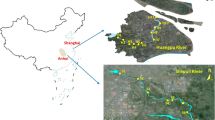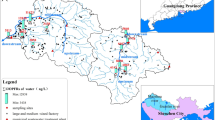Abstract
Investigating the organophosphate flame retardants (OPFRs) concentration and attenuation in multiple water of Beijing would provide valuable insight into OPFR management and reduction; thus, 6 OPFRs were determined by solid phase extraction-high performance liquid chromatography-tandem mass spectrometry to explore the pollution characteristics, and ecological risk of OPFRs. The results showed that 5 OPFRs were detected with a concentration ranging from ND to 394.77 ng/L except for tris(2,3-dibromopropyl) phosphate (TDBP). The chloroalkyl phosphate was the main compound and tris(chloropropyl) phosphate (TCPP) was the most abundant OPFRs with the highest concentration. The concentration of aryl-OPFRs in surface water and groundwater was much lower than that of chlorinated ones, and the concentration of chlorinated OPFRs in surface water was higher than that in groundwater. The treatment effect of chlorinated OPFRs including TCPP, TCEP, and TDCPP in STPs was negative. Ecological risk assessment showed that low risk of OPFRs for the organisms (algae, crustacean, and fish).



Similar content being viewed by others
Data Availability
All data generated or analyzed during this study are included in this published article and its supplementary information files.
References
Andresen, J., Grundmann, A., & Bester, K. (2004). Organophosphorus flame retardants and plasticisers in surface waters. Science of the Total Environment, 332, 155–166. https://doi.org/10.1016/j.scitotenv.2004.04.021
Batool, S., Gill, R., Ma, C., Reddy, G.C.S., Guo, W.W., & Hu, Y. (2020). Epoxy-based multilayers for flame resistant flexible polyurethane foam (FPUF). Journal of Applied Polymer Science, 137(29). https://doi.org/10.1002/app.48890
Chen, Y., Cao, Z., Covaci, A., Li, C., & Cui, X. (2019). Novel and legacy flame retardants in paired human fingernails and indoor dust samples. Environment International, 133, 105227. https://doi.org/10.1016/j.envint.2019.105227
Cho, K. J., Hirakawa, T., Mukai, T., Takimoto, K., & Okada, M. (1996). Origin and stormwater runoff of TCP (tricresyl phosphate) isomers. Water Research, 30, 1431–1438. https://doi.org/10.1016/0043-1354(96)00029-2
Du, J., Li, H., Xu, S., Zhou, Q., Jin, M., & Tang, J. (2019). A review of organophosphorus flame retardants (OPFRs): Occurrence, bioaccumulation, toxicity, and organism exposure. Environmental Science and Pollution Research, 26(22), 22126–22136. https://doi.org/10.1007/s11356-019-05669-y
He, C., Lin, C. Y., & Mueller, J. F. (2020). Organophosphate flame retardants in the environment: Source, occurrence, and human exposure - ScienceDirect. Comprehensive Analytical Chemistry, 88, 341–365. https://doi.org/10.1016/bs.coac.2019.10.008
He, J., Wang, Z., Zhao, L., Ma, H., Huang, J., Li, H., Mao, X., Huang, T., Gao, H., & Ma, J. (2021). Gridded emission inventory of organophosphorus flame retardants in China and inventory validation. Environmental Pollution, 290, 118071. https://doi.org/10.1016/j.envpol.2021.118071
Hou, R., Xu, Y., & Wang, Z. (2016). Review of OPFRs in animals and humans: Absorption, bioaccumulation, metabolism, and internal exposure research. Chemosphere, 153, 78–90. https://doi.org/10.1016/j.chemosphere.2016.03.003
Hou, L., Jiang, J., Gan, Z., Dai, Y., Yang, P., Yan, Y., Ding, S., Su, S., & Bao, X. (2019). Spatial distribution of organophosphorus and brominated flame retardants in surface water, sediment, groundwater, and wild fish in Chengdu, China. Archives of Environmental Contamination and Toxicology, 77(2), 279–290. https://doi.org/10.1007/s00244-019-00624-x
Huang, J., Ye, L., Fang, M., & Su, G. (2022). Industrial production of organophosphate flame retardants (OPFRs): Big knowledge gaps need to be filled? Bulletin of Environmental Contamination and Toxicology, 108(5), 809–818. https://doi.org/10.1007/s00128-021-03454-7
Ibáñez, M., Gracia-Lor, E., Bijlsma, L., Morales, E., Pastor, L., & Hernández, F. (2013). Removal of emerging contaminants in sewage water subjected to advanced oxidation with ozone. Journal of Hazardous Materials, 260, 389–398. https://doi.org/10.1016/j.jhazmat.2013.05.023
Kim, U.-J., & Kannan, K. (2018). Occurrence and distribution of organophosphate flame retardants/plasticizers in surface waters, tap water, and rainwater: Implications for human exposure. Environmental Science and Technology, 52, 5625–5633. https://doi.org/10.1021/acs.est.8b00727
Kim, U.-J., Oh, J. K., & Kannan, K. (2017). Occurrence, removal, and environmental emission of organophosphate flame retardants/plasticizers in a wastewater treatment plant in New York State. Environmental Science and Technology, 51, 7872–7880. https://doi.org/10.1021/acs.est.7b02035
Li, C., Chen, J. W., Xie, H. B., Zhao, Y. H., Xia, D. M., Xu, T., et al. (2017). Effects of atmospheric water on center dot OH-initiated oxidation of organophosphate flame retardants: A DFT investigation on TCPP. Environmental Science and Technology, 51(9), 5043–5051. https://doi.org/10.1021/acs.est.7b00347
Liang, K., & Liu, J. (2016). Understanding the distribution, degradation and fate of organophosphate esters in an advanced municipal sewage treatment plant based on mass flow and mass balance analysis. Science of the Total Environment, 544, 262–270. https://doi.org/10.1016/j.scitotenv.2015.11.112
Liu, X., Ji, K., Jo, A., Moon, H.-B., & Choi, K. (2013). Effects of TDCPP or TPP on gene transcriptions and hormones of HPG axis, and their consequences on reproduction in adult zebrafish (Danio rerio). Aquatic Toxicology, 134–135, 104–111. https://doi.org/10.1016/j.aquatox.2013.03.013
Loos, R., Carvalho, R., António, D. C., Comero, S., Locoro, G., Tavazzi, S., Paracchini, B., Ghiani, M., Lettieri, T., & Blaha, L. (2013). EU-wide monitoring survey on emerging polar organic contaminants in wastewater treatment plant effluents. Water Research, 47, 6475–6487. https://doi.org/10.1016/j.watres.2013.08.024
Marklund, A., Andersson, B., & Haglund, P. (2005). Organophosphorus flame retardants and plasticizers in Swedish sewage treatment plants. Environmental Science and Technology, 39, 7423–7429. https://doi.org/10.1039/B505587C
Möller, A., Sturm, R., Xie, Z., Cai, M., He, J., & Ebinghaus, R. (2012). Organophosphorus flame retardants and plasticizers in airborne particles over the Northern Pacific and Indian Ocean toward the polar regions: Evidence for global occurrence. Environmental Science and Technology, 46, 3127–3134. https://doi.org/10.1021/es204272v
National Bureau of Statistics of China. (2021). Main data of the seventh national population census. Retrieved from http://www.stats.gov.cn/sj/tjgb/rkpcgb/qgrkpcgb/202302/t20230206_1902003.html. Accessed 25 May 2023
Pang, L., Yang, P., Zhao, J., & Zhang, H. (2016). Comparison of wastewater treatment processes on the removal efficiency of organophosphate esters. Water Science and Technology, 74, 1602–1609. https://doi.org/10.2166/wst.2016.356
Pang, L., Yuan, Y., He, H., Liang, K., Zhang, H., & Zhao, J. (2016). Occurrence, distribution, and potential affecting factors of organophosphate flame retardants in sewage sludge of wastewater treatment plants in Henan Province, Central China. Chemosphere, 152, 245–251. https://doi.org/10.1016/j.chemosphere.2016.02.104
Pang, L., Yang, H. Q., Yang, P. J., Zhang, H. Z., & Zhao, J. H. (2017). Trace determination of organophosphate esters in white wine, red wine, and beer samples using dispersive liquid-liquid microextraction combined with ultra-high-performance liquid chromatography-tandem mass spectrometry. Food Chemistry, 229, 445–451. https://doi.org/10.1016/j.foodchem.2017.02.103
Reemtsma, T., Quintana, J. B., Rodil, R., Garcı, M., & Rodrı, I. (2008). Organophosphorus flame retardants and plasticizers in water and air I. Occurrence and fate. TrAC Trends in Analytical Chemistry, 27, 727–737. https://doi.org/10.1016/j.trac.2008.07.002
Regnery, J., & Puttmann, W. (2009). Organophosphorus flame retardants and plasticizers in rain and snow from Middle Germany. Clean-soil Air Water, 37(4–5), 334–342. https://doi.org/10.1002/clen.200900050
Regnery, J., & Püttmann, W. (2010). Occurrence and fate of organophosphorus flame retardants and plasticizers in urban and remote surface waters in Germany. Water Research, 44(14), 4097–4104. https://doi.org/10.1016/j.watres.2010.05.024
Saquib, Q., Al-Salem, A. M., Siddiqui, M. A., Ansari, S. M., Zhang, X., & Al-Khedhairy, A. A. (2022). Tris(2-butoxyethyl) phosphate (TBEP): A flame retardant in solid waste display hepatotoxic and carcinogenic risks for humans. Chemosphere, 296, 133977. https://doi.org/10.1016/j.chemosphere.2022.133977
Schreder, E. D., & La Guardia, M. J. (2014). Flame retardant transfers from US households (dust and laundry wastewater) to the aquatic environment. Environmental Science and Technology, 48, 11575–11583. https://doi.org/10.1021/es502227h
Schreder, E. D., & La Guardia, M. J. (2014). Flame retardant transfers from U.S. households (dust and laundry wastewater) to the aquatic environment. Environmental Science and Technology, 48(19), 11575–11583. https://doi.org/10.1021/es502227h
Shi, Y.-L., Gao, L.-H., Li, W.-H., Wang, Y., Liu, J.-M., Cai, Y.-Q. (2016). Occurrence, distribution and seasonal variation of organophosphate flame retardants and plasticizers in urban surface water in Beijing, China. Environmental Pollution, 209, 1–10. https://doi.org/10.1016/j.envpol.2015.11.008
Van der Veen, I., & de Boer, J. (2012). Phosphorus flame retardants: Properties, production, environmental occurrence, toxicity and analysis. Chemosphere, 88, 1119–1153. https://doi.org/10.1016/j.chemosphere.2012.03.067
Verbruggen, E., Rila, J., Traas, T., Posthuma-Doodeman, C., & Posthumus, R. (2006). Environmental risk limits for several phosphate esters, with possible application as flame retardant. RIVM rapport 601501024.
Wei, G.-L., Li, D.-Q., Zhuo, M.-N., Liao, Y.-S., Xie, Z.-Y., Guo, T.-L., Li, J.-J., Zhang, S.-Y., & Liang, Z.-Q. (2015). Organophosphorus flame retardants and plasticizers: Sources, occurrence, toxicity and human exposure. Environmental Pollution, 196, 29–46. https://doi.org/10.1016/j.envpol.2014.09.012
Wen, X., Shen, M., Han, H., Wang, A., & Zhai, J. (2018). Exposure level, toxicity effects and health risk assessment of organophosphorus flame retardants in water environment. Agricultural Science and Technology, 19(6), 31–42. https://doi.org/10.16175/j.cnki.1009-4229.2018.06.006
Yadav, I. C., Devi, N. L., Li, J., Zhang, G., & Covaci, A. (2018). Concentration and spatial distribution of organophosphate esters in the soil-sediment profile of Kathmandu Valley, Nepal: Implication for risk assessment. Science of the Total Environment, 613, 502–512. https://doi.org/10.1016/j.scitotenv.2017.09.039
Yan, X.-J., He, H., Peng, Y., Wang, X.-M., Gao, Z.-Q., Yang, S.-G., & Sun, C. (2012). Determination of organophosphorus flame retardants in surface water by solid phase extraction coupled with gas chromatography-mass spectrometry. Chinese Journal of Analytical Chemistry, 40(11), 1693–1697. https://doi.org/10.1016/S1872-2040(11)60586-0
Yang, C. M., Li, Y., Zha, D. P., Lu, G. H., Sun, Q., & Wu, D. H. (2017). A passive sampling method for assessing the occurrence and risk of organophosphate flame retardants in aquatic environments. Chemosphere, 167, 1–9. https://doi.org/10.1016/j.chemosphere.2016.09.141
Yang, J., Zhao, Y., Li, M., Du, M., Li, X., & Li, Y. (2019). A review of a class of emerging contaminants: The classification, distribution, intensity of consumption, synthesis routes, environmental effects and expectation of pollution abatement to organophosphate flame retardants (OPFRs). International Journal of Molecular Sciences, 20(12). https://doi.org/10.3390/ijms2012287450
Yao, C., Yang, H., Li, Y. (2021). A review on organophosphate flame retardants in the environment: Occurrence, accumulation, metabolism and toxicity. Science of The Total Environment, 795. https://doi.org/10.1016/j.scitotenv.148837.
Yu, K., Du, Z., Xuan, H., et al. (2022). Comprehensive analysis based in silico study of organophosphate flame retardants - Environmental explanation of bladder cancer progression[J]. Environmental Toxicology and Pharmacology, 92, 103851. https://doi.org/10.1016/j.etap.2022.103851
Zeng, X., He, L., Cao, S., Ma, S., Yu, Z., Gui, H., Sheng, G., & Fu, J. (2014). Occurrence and distribution of organophosphate flame retardants/plasticizers in wastewater treatment plant sludges from the Pearl River Delta, China. Environmental Toxicology and Chemistry, 33, 1720–1725. https://doi.org/10.1002/etc.2604
Zhang, L., Lu, L., Zhu, W., Yang, B., Lu, D., Dan, S. F., et al. (2021). Organophosphorus flame retardants (OPFRs) in the seawater and sediments of the Qinzhou Bay, Northern Beibu Gulf: Occurrence, distribution, and ecological risks. Marine Pollution Bulletin, 168, 112368. https://doi.org/10.1016/j.marpolbul.2021.112368
Zhang, Q., Li, J., Lin, S., Ying, Z., Hu, S., Wang, Y., & Mo, X. (2022). Organophosphate flame retardants in Hangzhou tap water system: Occurrence, distribution, and exposure risk assessment. Science of The Total Environment, 849, 157644. https://doi.org/10.1016/j.scitotenv.2022.157644
Zhong, M., Tang, J., Mi, L., Li, F., Wang, R., Huang, G., & Wu, H. (2017). Occurrence and spatial distribution of organophosphorus flame retardants and plasticizers in the Bohai and Yellow Seas, China. Marine Pollution Bulletin, 121, 331–338. https://doi.org/10.1016/j.marpolbul.2017.06.034
Acknowledgements
This work was financially supported by the National Natural Science Foundation of China (41877409) and Ministry of Science and Technology of China (Grant No. 2015FY110900).
Author information
Authors and Affiliations
Contributions
Shaoyong Lu, Weihua Cui, and Ying Zhang contributed to the conception of the study; Pan Qin and Xiaochun Guo contributed significantly to analysis and manuscript preparation; Yanmeng Zhang, Weihua Cui, and Na Zhang performed the data analyses and wrote the manuscript; Zhi Wang helped perform the analysis with constructive discussions.
Corresponding author
Ethics declarations
Ethical Approval
Not applicable.
Consent to Participate
Not applicable.
Consent for Publication
Not applicable.
Competing Interest
The authors declare no competing interests.
Additional information
Publisher's Note
Springer Nature remains neutral with regard to jurisdictional claims in published maps and institutional affiliations.
Yanmeng Zhang, Weihua Cui, and Na Zhang contributed equally to this work and should be considered co-first authors.
Supplementary Information
Below is the link to the electronic supplementary material.
Rights and permissions
Springer Nature or its licensor (e.g. a society or other partner) holds exclusive rights to this article under a publishing agreement with the author(s) or other rightsholder(s); author self-archiving of the accepted manuscript version of this article is solely governed by the terms of such publishing agreement and applicable law.
About this article
Cite this article
Zhang, Y., Cui, W., Zhang, N. et al. Occurrence and Risk of Organophosphate Flame Retardants in Multiple Urban Water of Beijing, China. Water Air Soil Pollut 234, 350 (2023). https://doi.org/10.1007/s11270-023-06277-w
Received:
Accepted:
Published:
DOI: https://doi.org/10.1007/s11270-023-06277-w




